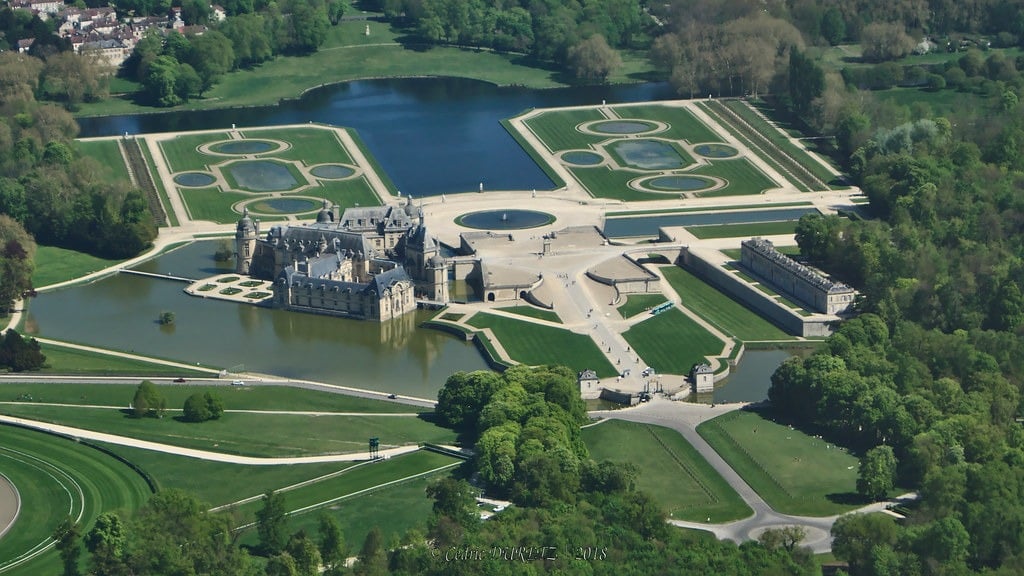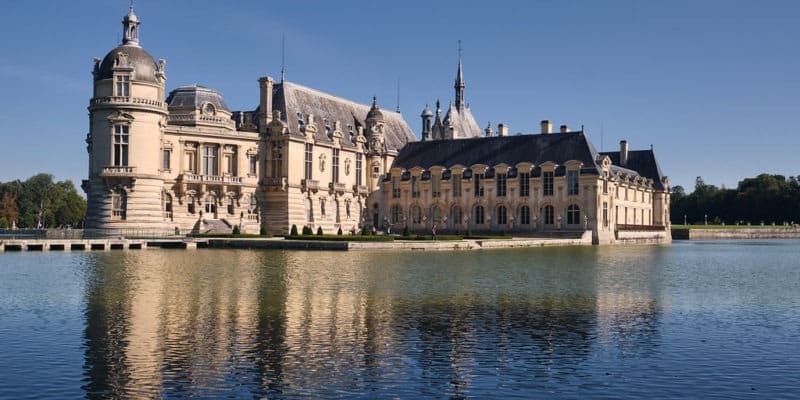The Château de Chantilly is an architectural and cultural masterpiece. Nestled in the heart of the Nonette valley in the Hauts-de-France region, this historic monument is a must-see for lovers of history, art and nature. This article introduces you to the riches of this exceptional château, its collections and gardens, and its fascinating history.
History of the Château de Chantilly
Origins and early construction
Château de Chantilly was originally a fortress built in the Middle Ages to defend the land from invasion. The site was chosen for its strategic position, in the heart of a valley surrounded by woods and crossed by the Nonette, a tributary of the Oise.
The Montmorency era
In the 16th century, the château passed into the hands of the powerful de Montmorency family. Constable Anne de Montmorency, a great friend of François I, undertook major renovations. It was during this period that the Petit Château was built, blending medieval style with Renaissance architecture. The Chantilly estate became a meeting place for the king’s court, attracted by the parties and sumptuous hunts organized by the connétable.
The Condé era
In 1643, on the death of the last Montmorency, the Chantilly estate was inherited by the Condé family, a younger branch of the House of Bourbon. The Princes de Condé, cousins of the King, maintained the château’s appeal as a center of cultural and intellectual life. They invited artists, poets and scholars to Chantilly, helping to enrich the château’s art and book collections.
The Duc d’Aumale and the 19th-century Restoration
In the 19th century, the Château de Chantilly underwent a new phase of transformation with the Duc d’Aumale, Henri d’Orléans, son of King Louis-Philippe. After inheriting the estate at the age of 8, he was forced into exile in England during the troubles of the 1848 Revolution. On his return to France in 1871, he undertook extensive restoration and construction work, resulting in the Grand Château we know today. A lover of art and history, the Duc d’Aumale amassed an unrivalled collection of art and books, which he bequeathed, along with the estate, to the Institut de France in 1886.
Château de Chantilly today
Today, the Château de Chantilly is a place of memory and culture, bearing witness to over six centuries of French history. Every year, it welcomes thousands of visitors from all over the world to discover its art collections, formal gardens and majestic architecture.

Portrait of the Duc d’Aumale, Henri d’Orléans, by Léon Bonnat
The castle and its buildings
Château de Chantilly comprises two distinct parts: the Petit Château, built in the 16th century for Anne de Montmorency, and the Grand Château, built in the 19th century by architect Honoré Daumet for the Duc d’Aumale.
The two buildings are linked by a gallery and surrounded by a moat. The château also houses a chapel, a hamlet, stables and several other outbuildings.
Le Petit Château
The Petit Château is the oldest part of the estate, built for Anne de Montmorency in the 16th century. With its architecture blending medieval and Renaissance elements, it bears witness to the importance of this transitional period in French art history.
The Petit Château is home to several remarkable rooms, including the Chambre des Singes, the Salle des Gardes and the Cabinet des Livres, which houses one of the world’s most valuable antique libraries.
Le Grand Château
The Grand Château, meanwhile, is a masterpiece of 19th-century architecture. It was designed by architect Honoré Daumet for the Duc d’Aumale, who wished to recreate the appearance of the original château, destroyed during the French Revolution. The Grand Château houses the private apartments of the duke and duchess, as well as the Musée Condé, where the duke’s art collections are on display.
The painting gallery and chapel
Linking the Petit and Grand Châteaux, the painting gallery is a must-see on the estate. It houses an exceptional collection of early paintings, including works by Raphael, Fra Angelico, Poussin and Delacroix. Nearby, the château chapel, dedicated to Saint-Louis, is a jewel of Gothic art, with its colorful stained-glass windows and elegant vaults.
The hamlet and stables
Away from the château, the hamlet, inspired by Queen Marie-Antoinette’s hamlet in Versailles, offers a charming, bucolic setting. Composed of several half-timbered houses, it bears witness to the taste for a return to nature that prevailed at the end of the 18th century. Finally, the stables are among the most beautiful and largest in France. They now house the Musée du Cheval, which traces the history of the relationship between man and horse.
Other dependencies
The Chantilly estate also includes several other outbuildings, including the Jeu de Paume, the Maison de Sylvie, the Orangerie and the Pavillon de Manse. Each of these buildings has its own history and contributes to the richness of the château’s heritage.
The Musée Condé collections
An impressive art collection
The Musée Condé, located within the Château de Chantilly, is the fruit of the Duc d’Aumale’s passion for art. During his lifetime, he amassed a collection of works of art and rare books that ranks among the most important in France. The museum houses an exceptional collection of paintings, drawings and engravings by some of the greatest masters in the history of art. Works by Raphaël, Nicolas Poussin, Jean-Auguste-Dominique Ingres, Eugène Delacroix and many others can be found here.
The collection of antiquarian books and manuscripts
In addition to its collection of paintings, the Musée Condé boasts an exceptional library of antiquarian books and manuscripts. It comprises over 13,000 volumes, including 1,500 medieval and Renaissance manuscripts. Among the treasures of this collection are a copy of Dante’s “Divine Comedy”, illustrated by Botticelli, and first editions of the works of Molière and Racine.
The Très Riches Heures of the Duc de Berry
The Musée Condé’s masterpiece is undoubtedly“Les Très Riches Heures du Duc de Berry“. This 15th-century illuminated manuscript is considered one of the most beautiful and precious in the world. It is the work of the Limbourg brothers, three painters and miniaturists from the Netherlands. The book, which contains prayers to be recited at different times of the day (hence the term “hours”), is famous for its colorful miniatures depicting the activities of the months of the year, the saints and scenes from the life of Christ.

Gallery of paintings at Château de Chantilly
The estate gardens
French gardens
The formal gardens of Château de Chantilly are among the most beautiful in France. Designed by André Le Nôtre, Louis XIV’s celebrated gardener, who also designed the gardens at Versailles, they are an outstanding example of 17th-century garden design. Structured by straight paths and parterres de broderies, the gardens offer majestic views of the château and its water features.
The Anglo-Chinese garden and hamlet
The Anglo-Chinese garden, laid out in the 18th century, is a place of charm and poetry. Inspired by the period’s taste for exoticism and wilderness, it has a freer, more picturesque aesthetic than French gardens. At the heart of the garden is the hamlet, a collection of half-timbered houses evocative of 18th-century rural life. With its vegetable gardens, orchards and animals, the hamlet is a place of discovery and wonder for young and old alike.
Chantilly State Forest
Finally, the Chantilly estate includes a vast state-owned forest extending over 6,000 hectares. This forest, criss-crossed by numerous footpaths, is a haven of peace and biodiversity. It is home to a rich flora and fauna, with deer, roe deer and wild boar, as well as numerous species of birds and plants.

Aerial view of the Château de Chantilly and its gardens
Location of the château
P.N.
